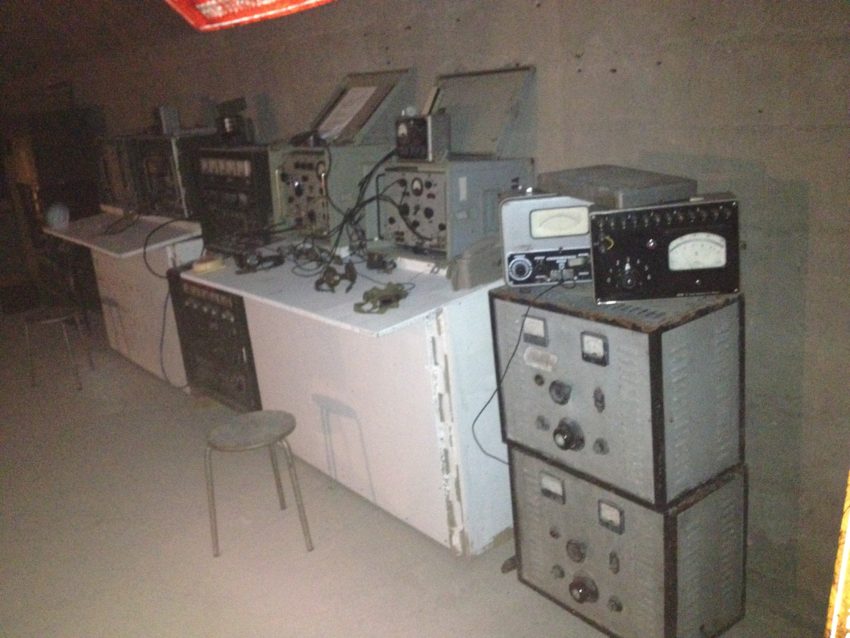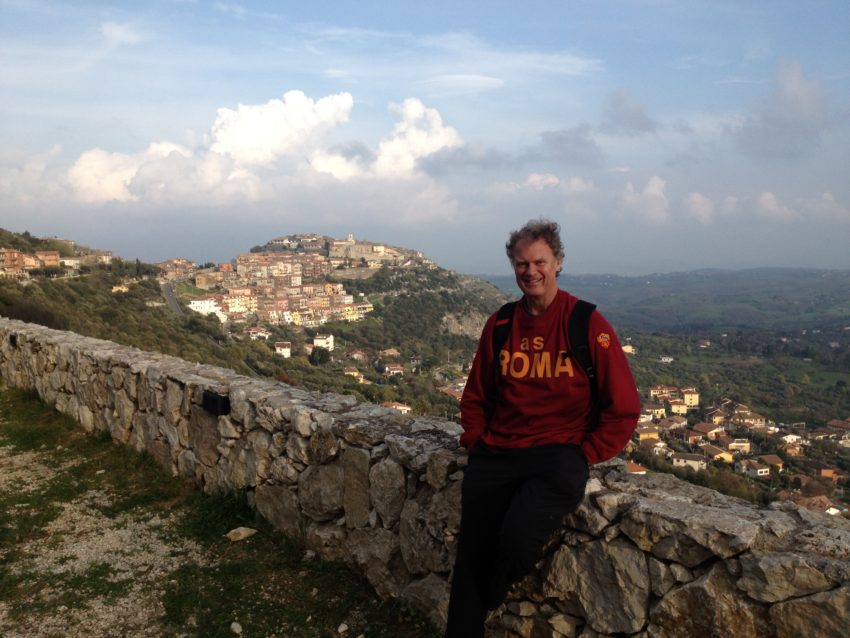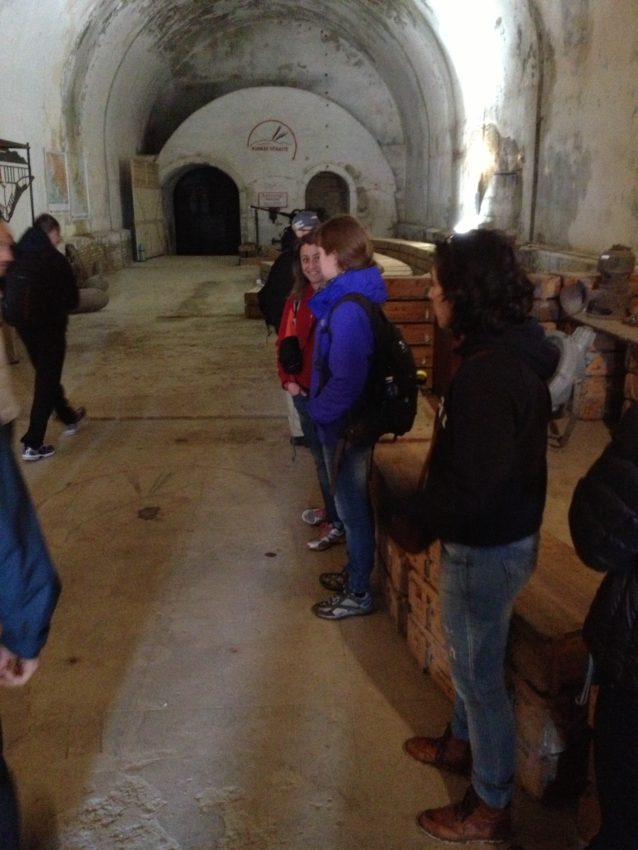Retired in Rome Journal: Mussolini’s Bunker a 2.4-mile maze of dark history and mystery



SANT’ORESTE, Italy — Romance pours from every corner of Italy like honey from a punctured bottle. Piazzas. Opera music. Wine. Mussolini …
… OK, so Italy has a dark side. I visited it yesterday. And that dark side is as black as a fascist’s heart — or the inside of the tunnels that Mussolini hid in during World War II.
I’ve had a weird fascination with Benito Mussolini ever since I read about him during my first stint here from 2001-03. He was a fierce nationalist who tried to make his country a player on the world stage. He had some leadership qualities that any general in the U.S. could admire. The son of a socialist blacksmith in the small Emilia-Romagna town of Dovia di Predappio, Mussolini got booted from the socialist party and founded Italy’s first fascist party. In his early years, he did a lot of good. He helped nationalize a language in a country fractured by dialects and millenium-long regional rivalries. He turned the swamps outside of Rome into commerce centers and charming, livable villages. And, as his legacy still states, he got the trains to run on time. He did nothing with the bus system, which still sucks, but that’s Rome’s problem now. His problem was he had this weird crush on Adolph Hitler, which, obviously, became the ultimate fatal attraction. Mussolini also ill equipped his military to the point where it couldn’t compete in a world war. What was left after the war was Mussolini hanging from his toes in a Milan piazza and Italy falling into an economic mess from which it took decades to recover.
(I had a first-hand encounter with Italy’s post-war troubles when I moved here in 2001. My then-girlfriend and I stayed in a small, family run pensione for a week while looking for an apartment. The owner’s mother was a young girl in Rome after the war. Today she still can’t eat tomatoes because as a girl, that’s all she had to eat.)
The trains aren’t the most obvious leftover from Mussolini’s footprint. He built a massive bunker in a mountain north of Rome. He said it was a weapons factory. In actuality, it was a hideout. Dark, eerie and cold, it exists today with just enough of his fingerprints to give you a feel of fascist Italy in World War II.
I toured one of Rome’s most off-the-beaten-path sites with good ol’ Rome Explorers, the terrific meetup group that brings Rome’s fascinating history to you up close and personal. Fourteen of us took a little regional train an hour north of Rome to the charming hill town of Sant’Oreste. It was another varied group. I was joined by a bunch of young Scandinavian women working for World Food Program, an Aussie and his Swedish girlfriend with WFP (WFP employs 1,000 people and seemingly every expat in Rome except for me and the Africans selling knock-off Gucci bags by the Vatican.), a Bolivian dental hygienist, an English journalist and some Italian history/hiking buffs.
Mussolini had the good sense of building his hideout in a spectacular setting. Sant’Oreste is at the foot of Mont Soratte, a forest-covered, multi-peaked mountain of modest dimensions but awesome views of the entire Lazio region. We all gathered outside a tiny caffe where gray clouds put the entire area in a cloak of mist, giving this region with the dark past an even more foreboding present. We walked a well-marked dirt trail that looked like a narrow service road. We soon came upon a red arrow pointing up — straight up — and made about a 20-minute steep ascent through thick forest. The cool 45-degree air was perfect for a strenuous stretch and reaching above the tree line made it all worth it. Below was all of north Lazio. We were only about 30 miles north of Rome yet all we saw was green farmland dotted with oak trees, small farm dwellings and rolling hills beyond.
Rainfall made negotiating the narrow, rocky trail a challenge as we traversed a saddle between peaks. We wound up at a small concrete church dating back to the early 4th century. It’s dedicated to Pope Sylvester, the Vatican’s first Christian pope who helped pave the way for Christian acceptance after centuries of bloody persecution under Roman rule. The Romans built this church in 300 AD as a temple to Apollo, not to mention as a lookout for invading armies that were attacking Rome in an increasing fashion. Pope Constantine persecuted Sylvester for his bombastic religious ways but when Constantine fell ill, Sylvester cured him in this church. After that, Constantine legalized the Christian religion and San Silvestro became its first pope.
Here, not far from where Sylvester slept, we had lunch.
Mussolini obviously never found inspiration in Sylvester’s kindness. While Hitler was toying with his obtuse affections (Mussolini built the Pyramide Metro stop near my new apartment strictly to impress Hitler on his first visit.) and the Americans were bombing at his heels, Mussolini went just outside Sant’Oreste and went to work. He built 2.4 miles of tunnels inside the mountain. Doors are two feet thick. Walls are eight meters of concrete. Started in 1937, it took him six years — not coincidentally until the time the U.S. ran Mussolini out of power. In 1943, with the big fat fuck gone, the Italian workers dropped their shovels and stopped digging. The Germans took it over which is why when we entered, we saw on one door, “ACHTUNG! ZSTRITT VERBOTEN” (ATTENTION! STRICTLY FORBIDDEN.) The first room isn’t terribly impressive. It’s a big open space with a white, rounded ceiling and scruffy floor. It’s very well lit. It could pass for an abandoned VFW post.
But then the pretty blonde guide (Wearing camouflage battle fatigues was a nice touch. Her cell phone’s dial tone taken from the theme song from “Psycho” seemed particularly appropriate here, too), took us out the back of the room, it got weird. The network of tunnels makes Mussolini’s bunker look like an ant hill. We walked along deep, pitch-black corridors with our flashlights skipping over a beat-up concrete floor. The hallways connected massive rooms with piles of broken-down equipment. Mussolini did use these rooms to build weapons. Shifts of 30-40 workers worked around the clock in rooms where you can still see the giant holes where ventilator pipes fit. The air in this cave while building weapons must’ve been absolutely toxic.
But it worked. The U.S. military had no idea this existed. It wasn’t discovered until the Germans ran it and a U.S. reconnaissance plane took photos of what looked like a structure sticking out of a mountain outside Rome. On Sept. 19, 1944, the U.S. peppered it with bombs. They destroyed the outside but the inside remained intact. So did the Germans inside.
The Germans turned this place into a living hell. Not only were working conditions apparently awful, but we saw the remains of a bed, in the bottom of a hole about 20 feet deep. Discoveries of another bed not far away brought the conclusion that the Germans also used this place as a prison, too. For its workers, it eventually became a cemetery. In 1944, the SS, the German secret service, took gold from the Bank of Italy and gave it to its soldiers to bury in the bunker. As payment for the soldiers’ hard work, the SS killed them. You know, just in case they talked. One German survived. Wally Vogt returned to Germany and after the war he tried to return to the bunker to, what he told the locals, “just to have a look around.” They probably wondered why he had a huge satchel looped over his shoulder. Wally Vogt was found burned to death in his home. No gold has been found since.
The bunker was used in the 1970s to store weapons but today it’s a fascinating slice of life during World War II. We’d walk around a corner and flash our lights on a tank pointing an anti-aircraft gun at our faces. We saw a dormitory with beds still lined up in neat rows, oddly making the room look like a mental ward. We saw the recreation of a German military command post, complete with circa 1940s radio equipment and typewriters the size and general weight of television sets.
I talked to the guide about what Italians are taught in school about Mussolini. “We read that he did some good things,” she said. “But he did some bad things, too.”
Deep in the misty hills of rural Lazio, proof will always remain.


March 29, 2014 @ 2:39 pm
Great story. I was just watched the movie “Tea with Mussolini”. I am sure you probably saw it once. Anyway, glad you are doing well.